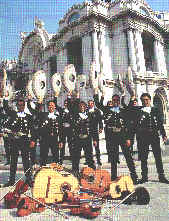|
|
They are unquestionably one of the most popular symbols of Mexican folklore. Their music is in demand for lovers' serenades and to add touch of live oompb to parties.
Their standard attire since 1903 is the traditional colonial charro suit of short fitted jacket, pants with linked silver buttons running down the sides, suede boots and wide-brimmed sombrero.
September 29 is "National Mariachi Day".
Origin of the word "mariachi" has long been subject of debate. Some people erroneously claim it comes from the name of a tree, others from French word "marriage" (1862). The truth is that historians have found documents relating the term with ancient bynm "Maria Ce Son" (1695), which the indigenous people of Cocula sang to "Virgin de la Pila" and pronounced "Maria-she son". The subsequent derivative "mariachi" was used to refer to the group of musicians who sang and played it.
Today's mariachis accompany their voices with violins, trumpets, guitars, base guitar and other type of guitar called "vihuela". They play waltzes, polkas and traditional Mexican rhythms such as jarabes, sones and corridos. Their presence is indispensable at any cockfight, rodeo and outdoor fiestas and dances. They eulogize Mexican personality.
Mariachis first came to Mexico City in 1896. In 1905, Justo Villa mariachi band led the celebrations in honor of President Porfirio Diaz's saint's day and National Independence.
From 1930s to 50s, Mexican movies helped popularize mariachis from Cocula. Noted composers, singers and actors like Jorge Negrete, Pedro Infante, Jose Alfredo Jimenez and Lola Beltran immortalized Mexican sound and took it beyond national frontier.

|
|

